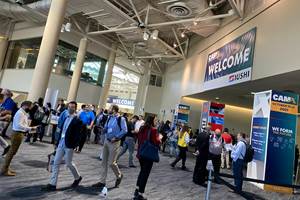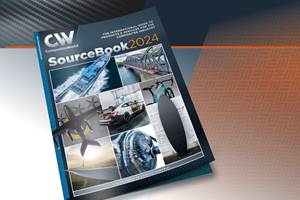Lessons learned, a year later
When the pandemic struck, we yearned for normality. Getting back there will take time and patience.

It’s been about a year since the coronavirus became a pandemic, and with vaccines in distribution, many of us are now trying to imagine what life might be like in a world where the virus is, if not eradicated, at least under control and manageable.
I know that many of us would like to think that we can simply revert to all of our pre-pandemic behaviors, both socially and professionally — traveling for work or for pleasure, gathering at will with friends and family, attending sporting events, attending trade shows and conferences, visiting customers and/or suppliers.
Reverting to this pre-pandemic behavior, however, assumes that the environment in which we live our lives has remained unchanged. In fact, it is rather difficult to think about an aspect of our lives that has not been touched and changed by the pandemic. Therefore, moving forward in this post-pandemic world — successfully — will require some recalibration of ourselves and the composites industry as a whole, recognizing what has changed and how that might affect our options and actions.
This begs the question: What has changed in the composites industry that should be recognized and accounted for? Or, perhaps more importantly, what have we learned in the last 12 months?
The first and most obvious thing we have learned is just how valuable commercial air travel is, and how much we took it for granted. The implications of severely limited air travel are many, but for the composites industry, there are two big ones. The first, of course, is the large and negative impact on aircraft production. Aerospace is the most valuable end market served by the composites industry, thus the reduction of build rates by Boeing and Airbus that have trickled down throughout the supply chain, putting substantial economic pressure on fabricators, moldmakers and raw material suppliers. The second implication is the restriction on in-person interaction among composites industry professionals, whether at trade shows, conferences, plant visits, etc. Composites manufacturing, as you know, is highly tactile and demands a certain level of physical interaction to understand how resins and fibers are combined to make a finished part. Virtual interactions, videos and photos can be helpful, but at some point that in-person connection becomes essential to advance ideas and technologies.
What has changed in the composites industry that should be recognized and accounted for?
The second thing we have learned is that in an asymmetrical economic downturn, such as that wrought by the pandemic, there are winners as well as losers. As I noted in my January editorial, the social interaction limits imposed by the pandemic have driven consumers to outdoor activities, made apparent by the substantial increase in demand for boats, recreational vehicles and sporting goods within the last 12 months. And the global wind energy industry enjoyed one of its strongest years ever in 2020, even with a pandemic-induced slowdown last spring.
The third thing we have learned — are learning — is that the global supply chain that delivers raw materials to manufacturers has some vulnerabilities that we are still struggling to come to terms with. For example, as the recreational marine and recreational vehicle markets surged in 2020, the supply of glass fiber gun rovings tightened. The result is long lead times for rovings deliveries, and higher prices. The causes of this tight supply are numerous. First, the vast majority of the world’s glass fiber rovings comes out of China, and as the Chinese economy recovered in late 2020, demand within China for rovings increased. On top of that, Chinese rovings suppliers, which until recently had been paying — in an effort to maintain market share — the 25% tariff on product exported to the U.S., decided to stop paying the tariff and implemented a 20% price hike on their U.S. customers. Overlaying all of this is a global supply imbalance of shipping containers. The pandemic has limited the supply of manual labor at major sea ports, thus many containers are spending more time than usual either on a ship awaiting unloading, or on the dock awaiting processing. This has, in turn, slowed the circulation of shipping containers between and among trading countries.
The bottom line is that even if the global economy was brought to a hard and sudden stop by the pandemic, emergence from it has been and will continue to be uneven, with incremental and sporadic return to some of the norms we knew before. Ultimately, however, I believe strongly that we will be interacting in-person again, wherever that may be. And I hope to see you there.
Related Content
CAMX 2022: 10 reasons to attend
Looking for a good reason to attend CAMX 2022? Look no further.
Read MoreCompositesWorld is on the road again
Since CW’s infancy, its editors have strived to imbue its coverage with a sense of place, whether that’s through plant tours, facility visits or trade shows. After a pandemic, this has never seemed more important.
Read MoreCompositesWorld SourceBook 2024
Welcome to CW’s annual SourceBook, your guide to suppliers of machinery, materials, software and other services for the composites industry.
Read MoreWhy aren't composites synonymous with infrastructure?
The U.S. seems poised to invest heavily in infrastructure. Can the composites industry rise to the occasion?
Read MoreRead Next
From the CW Archives: The tale of the thermoplastic cryotank
In 2006, guest columnist Bob Hartunian related the story of his efforts two decades prior, while at McDonnell Douglas, to develop a thermoplastic composite crytank for hydrogen storage. He learned a lot of lessons.
Read MoreComposites end markets: Energy (2024)
Composites are used widely in oil/gas, wind and other renewable energy applications. Despite market challenges, growth potential and innovation for composites continue.
Read MoreCW’s 2024 Top Shops survey offers new approach to benchmarking
Respondents that complete the survey by April 30, 2024, have the chance to be recognized as an honoree.
Read More















.jpg;maxWidth=300;quality=90)









